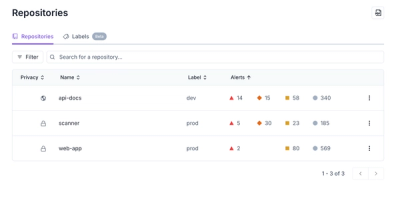
Security News
VulnCon 2025: NVD Scraps Industry Consortium Plan, Raising Questions About Reform
At VulnCon 2025, NIST scrapped its NVD consortium plans, admitted it can't keep up with CVEs, and outlined automation efforts amid a mounting backlog.
traveltime-google-comparison
Advanced tools
Compare travel times obtained from TravelTime API and Google Maps API
This tool compares the travel times obtained from TravelTime Routes API, Google Maps Directions API, TomTom Routing API, HERE Routing API, Mapbox Directions API, OpenRoutes API, and OSRM Routes API. Source code is available on GitHub.
The tool requires Python 3.8+ installed on your system. You can download it from here.
Create a new virtual environment with a chosen name (here, we'll name it 'env'):
python -m venv env
Activate the virtual environment:
source env/bin/activate
Install the project and its dependencies:
pip install traveltime-google-comparison
Provide credentials and desired max requests per minute for the APIs inside the config.json file.
You can also disable unwanted APIs by changing the enabled value to false.
{
"traveltime": {
"app-id": "<your-app-id>",
"api-key": "<your-api-key>",
"max-rpm": "60"
},
"api-providers": [
{
"name": "google",
"enabled": true,
"api-key": "<your-api-key>",
"max-rpm": "60"
},
...other providers
]
}
Run the tool:
traveltime_google_comparison --input [Input CSV file path] --output [Output CSV file path] \
--date [Date (YYYY-MM-DD)] --start-time [Start time (HH:MM)] --end-time [End time (HH:MM)] \
--interval [Interval in minutes] --time-zone-id [Time zone ID]
Required arguments:
--input [Input CSV file path]: Path to the input file. Input file is required to have a header row and at least one
row with data, with two columns: origin and destination.
The values in the columns must be latitude and longitude pairs, separated
by comma and enclosed in double quotes. For example: "51.5074,-0.1278". Columns must be separated by comma as well.
Check out the project's repository
for examples in the examples directory and more pre-prepared routes in the inputs directory.--output [Output CSV file path]: Path to the output file. It will contain the gathered travel times.
See the details in the Output section--date [Date (YYYY-MM-DD)]: date on which the travel times are gathered. Use a future date, as Google API returns
errors for past dates (and times). Take into account the time needed to collect the data for provided input.--start-time [Start time (HH:MM)]: start time in HH:MM format, used for calculation of departure times.
See Calculating departure times--end-time [End time (HH:MM)]: end time in HH:MM format, used for calculation of departure times.
See Calculating departure times--interval [Interval in minutes]: interval in minutes, used for calculation of departure times.
See Calculating departure times--time-zone-id [Time zone ID]: non-abbreviated time zone identifier in which the time values are specified.
For example: Europe/London. For more information, see here.Optional arguments:
--config [Config file path]: Path to the config file. Default - ./config.jsonExample:
traveltime_google_comparison --input examples/uk.csv --output output.csv --date 2023-09-20 \
--start-time 07:00 --end-time 20:00 --interval 180 --time-zone-id "Europe/London"
Script will collect travel times on the given day for departure times between provided start-time and end-time, with the given interval. The start-time and end-time are in principle inclusive, however if the time window is not exactly divisible by the given interval, the end-time will not be included. For example, if you set the start-time to 08:00, end-time to 20:00 and interval to 240, the script will sample both APIs for departure times 08:00, 12:00, 16:00 and 20:00 (end-time included). But for interval equal to 300, the script will sample APIs for departure times 08:00, 13:00 and 18:00 (end-time is not included).
The output file will contain the origin and destination columns from input file, with additional 4 columns:
departure_time: departure time in YYYY-MM-DD HH:MM:SS±HHMM format, calculated from the start-time, end-time and interval.
It includes date, time and timezone offset.google_travel_time: travel time gathered from Google Directions API in secondstt_travel_time: travel time gathered from TravelTime API in secondserror_percentage_*: relative error between provider and TravelTime travel times in percent, relative to provider result.origin,destination,departure_time,google_travel_time,tomtom_travel_time,here_travel_time,osrm_travel_time,openroutes_travel_time,mapbox_travel_time,tt_travel_time,error_percentage_google,error_percentage_tomtom,error_percentage_here,error_percentage_mapbox,error_percentage_osrm,error_percentage_openroutes
"52.200400622501455, 0.1082577055247136","52.21614536733819, 0.15782831362961777",2024-09-25 07:00:00+0100,621.0,805.0,614.0,532.0,697.0,1018.0,956.0,53,18,55,6,79,37
This project is licensed under MIT License. For more details, see the LICENSE file.
FAQs
Compare travel times obtained from TravelTime API and Google Maps API
We found that traveltime-google-comparison demonstrated a healthy version release cadence and project activity because the last version was released less than a year ago. It has 1 open source maintainer collaborating on the project.
Did you know?

Socket for GitHub automatically highlights issues in each pull request and monitors the health of all your open source dependencies. Discover the contents of your packages and block harmful activity before you install or update your dependencies.

Security News
At VulnCon 2025, NIST scrapped its NVD consortium plans, admitted it can't keep up with CVEs, and outlined automation efforts amid a mounting backlog.

Product
We redesigned our GitHub PR comments to deliver clear, actionable security insights without adding noise to your workflow.

Product
Our redesigned Repositories page adds alert severity, filtering, and tabs for faster triage and clearer insights across all your projects.